by Winding Pathways | Jan 30, 2016 | Nature, Trees/Shrubs

Catalpas are tough trees that thrive in hostile environments. Their beautiful blooms attract pollinators.
We recently invited our neighbors to Winding Pathways for an evening of conversation. It was early winter and talk turned to trees.
“We have an odd tree growing in our yard. I have no idea what it is, but it has bit heart shaped leaves and later in the summer long beans dangle down from it,” said Patty a neighbor from down the street.
Her description was perfect. It was a Northern Catalpa. No other tree matches her observations.
Winter is a wonderful time to study trees. In midsummer their branch structure and twigs are usually invisible beneath leafy clothing. Not so in winter when buds, twigs, trunk, and branches can be easily seen. Often they yield clues revealing its species.
One of our favorite tree finding tools is on the Website of the National Arbor Day Foundation. Click on the “tree” tab and a simple identification guide pops up like magic on the computer screen. The Arbor Day Foundation also sells dozens of tree species at reasonable prices and a visit to Arbor Day farm in Nebraska City, Nebraska is memorable. It’s just south of Omaha and is where J. Sterling Morton founded Arbor Day.
by Winding Pathways | Jan 18, 2016 | Geology/Weather, Nature, Preparedness

Dress in Layers, wear sturdy, insulted boots, and soak up Vitamin D with a brief “sun bath” even on cold winter days.
The woman giving our local television station’s weather report issued a dire warning. “It’s going to be below zero tomorrow with strong wind. It will feel like 30 below zero out. Stay inside”, she advised!
A gorgeous sunrise launched the next morning. It was a cold six below zero out but with only slight wind. Birds and squirrels arrived at the feeder, snatched a few seeds and flew or scampered off to enjoy breakfast in a sunny spot sheltered from the breeze.
Rarely do we have weather so bad that everyone must stay indoors. Certainly some days are more pleasant than others but at Winding Pathways we go outside, even if briefly, whether it’s frigid or broiling out -mainly to tend our animals. We mimic wildlife.
When August’s heat and humidity envelop Iowa we follow the pattern of the cottontail that lives in our yard. He and we are out in the evening and early morning. In mid-day we shun the sun and enjoy our maple’s cool shade. On blustery winter days we layer up and explore our yard, even if for just a short time. Modern clothing is amazingly effective keeping us comfortable as long as we do like our chickadees and find a sunny place out of the wind. We don’t fool around with tornadoes. If one’s approaching we heed the weather caster’s advice and stay in the basement. But, as soon as it passes we’re out in the yard.
Take temperature extremes seriously. Unusually hot or cold weather can cause serious physical problems, even death, but a prudent person who takes precautions and uses common sense will enjoy fresh air even in extreme weather.
BE CAREFUL, DRESS APPROPRIATELY, AND AVOID BEING UNDULY “SCARED” BY THE WEATHER REPORT.
“Climb the mountains and get their good tidings. Nature’s peace will flow into you as sunshine flows into trees. The winds will blow their own freshness into you, and the storms their energy, while cares will drop off like autumn leaves,” John Muir.
by Winding Pathways | Jan 8, 2016 | Nature, Pests
Most people love watching wildlife in their yards, and millions set out bird feeders and improve habitat to encourage colorful and fascinating animals. But there’s a limit.
See a mouse scurry across the floor or find their droppings on the kitchen counter and most families quickly set snap traps to kill the pests. Although there are ways to reduce or prevent most wildlife problems that usually should be tried first, sometimes it’s necessary to kill an animal.
Take woodchucks, for example. These large mammals are capable climbers and powerful diggers. They tunnel under any fence they can’t climb over. A woodchuck’s sweet tooth is the family garden and they readily clear cut carrots, peas, beans, corn, chard and most other crops.
A few July’s ago our garden looked superb. We were harvesting crops like beans, squash, beets and chard. One afternoon we went out to pick a few dinner vegetables and were astonished to find the beans nearly eaten to the ground, the chard gone and the beet tops nibbled to nubbins. It wasn’t the raid of a woodchuck. A whole family of chucks had chosen to squeeze under the fence and convert our garden into their lunch.
We do what we can to prevent or reduce damage. The garden has a sturdy fence around it that keeps deer and rabbits out, but with their superior climbing and digging ability we found that keeping chucks out is nearly impossible.
Our garden is a vital part of our family’s food supply so raiding woodchucks gets the same treatment as a mouse in the kitchen. Fortunately, our home is situated where it is legal and safe to shoot an occasional garden raider. Millions of homeowners live on acreages where they can legally dispatch pests. But it must be done safely. Having a low power firearm or airgun handy can be a garden savior.
We use both a .22 caliber rifle and a .22 caliber airgun both to dispatch an occasional pest and for target practice. Again, shooting a pest is a last resort that we use only when prevention fails, but normally we have to do in a few woodchucks every year.
HOW FIREARMS AND AIRGUNS WORK
Airguns and firearms have similarities and differences. Each relies on air pressure to push a projectile (bullet or pellet) out the barrel and onward to its target. Each can be a safe, effective, and humane tool for dispatching pests but must be used with great care and moderate skill.
When someone pulls a firearm’s trigger a pin strikes the primer of a loaded shell. The impact causes the primer to create a spark that ignites gunpowder. Rapidly burning powder creates tremendous air pressure that pushes the bullet out the barrel.
Pull the trigger on an airgun and high pressure air, already inside, pushes the projectile forward without an explosion of gunpowder. The pressure is generated before shooting by either pumping the barrel or a lever or by inserting a cartridge of pressurized carbon dioxide.
DEVELOPING SHOOTING SKILL
Appropriate airguns and .22 rifles are capable of quickly and humanely dispatching small pests but each can cause severe injury or even death of a person. They must be used with skill and care. Winding Pathways owners Rich and Marion Patterson have extensive experience with firearms. She grew up in rural New Hampshire in a family that hunted for food and also occasionally needed to dispatch a pest raiding their huge garden. He learned shooting during a stint in the army. Many homeowners lack shooting skills and safety knowledge. A good way to gain both is to enroll in a hunter safety course offered in most areas. To locate a class check Where to Hunt. Instructors help novices learn safety and accurate shooting. Many shooting ranges also offer training and are excellent and safe places to practice, sometimes with a coach to help out. To locate a range near your home access Where To Shoot.
Accurate shooting is essential for humane and safe pest control. A precise shot to the vitals will instantly kill a woodchuck while a poor shot will only wound the animal and cause suffering. Develop skill and practice!
.22 RIFLES
At Winding Pathways we often spot our garden-raiding woodchuck close to our home and use our .22 rimfire rifle to dispatch it. Ours is a bolt action that functions with a diversity of ammunition types. The most powerful are called “long rifle” shells. We avoid them because they are overly powerful and noisy. Instead we use either “shorts” or, more frequently, “CB” shells. CB shells have only a small amount of powder and make little noise. They have plenty of power to dispatch a woodchuck hit in the head at 25 feet. Shorts have more power than CB’s but less than long rifles. They extend the effective range but are noisier.
AIRGUNS
Airguns, sometimes called BB guns, vary greatly in quality and power. Old fashioned BB guns fired a round piece of steel called a “BB”. Generally they lack both power and accuracy for serious pest control, but modern airguns are a different matter. Many are of .177 caliber but some are of .22 caliber, which fire a larger heavier pellet that is more lethal than the smaller one. A common system of charging an airgun is to compress air by cocking the barrel. Some airguns will dispatch a pest as humanely as a firearm, but be careful.
Please note: There are pellet guns and there are pellet guns. Some are powerful enough to humanely dispatch a woodchuck and other pests while others lack sufficient power. Our Benjamin .22 titan shoots a 14.3 grain pellet at 750 feet per second, packing enough energy to kill a woodchuck at 25 yards if hit in a lethal area. Another of our pellet guns is much lower powered and is used strictly for target practice.
CAUTION
Before using an airgun or rifle on your property:
- Make sure it’s legal and safe.
- Become familiar with the airgun or firearm. Read the owner’s manual.
- Always practice safety and treat your airgun or .22 as if it’s loaded.
- Develop skill. Never shoot at a pest until you have mastered accuracy and can kill it humanely. Practice often.
- Store it safely. We keep ours in a large locked box, where it stays until used. Store ammunition away from the weapon. Always keep a weapon away from children.
FOR FUN
We enjoy target shooting and have made a simple range in our backyard. Every once in a while we take the airgun out and enjoy punching holes in paper targets.
FOR INFORMATION
For general information on shooting, safety and where to find a place to shoot go to the National Shooting Sports Foundation.
by Winding Pathways | Jan 4, 2016 | Nature, Travel/Columns, Wonderment
-

-
Our winter wreath will soon sport hearts and last us through the season.
-
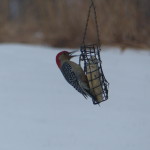
-
Wintering woodpeckers, including the pileated, gobble up suet.
-
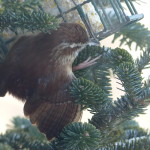
-
A lone Carolina Wren has hung around and appreciates the suet on our outdoor Christmas Tree.
-
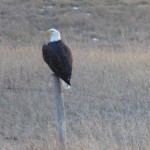
-
Eagles have come down from the north. As waterways freeze over they concentrate below roller dams.
-
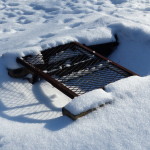
-
Lonely winter grill
-
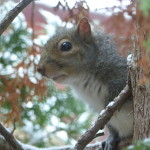
-
A cautious squirrel scoping out the action.
-
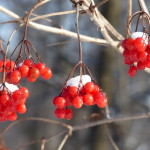
-
The birds have not yet flocked to the High Bush Cranberries but will later in the winter.
by Winding Pathways | Jan 2, 2016 | Nature, Reflections/Profiles, Wonderment

This great book is colorful, factual and encourages folks to “Go Outside!”
As kids growing up, we read books our classmates would have considered weird. They were field guides to birds, mammals, fish, wildflowers, rocks and the weather. Color plates of animals, trees and all sorts of other living things fascinated us. Range maps taught geography, and the text good writing.
With the rapid growth of apps to help identify many objects of nature, field guides may be slipping from winter reading lists, but there is one new book that any nature lover should have handy.
The Secret Lives of Animals includes 1001 tidbits, oddities and facts about North America’s wild animals. It’s not a book to read cover to cover. It is one to pick up when there are a few spare minutes for learning and enjoyment. There’s learning on every page. We see two audiences who will enjoy having this book close by.
Kids and adolescents: With colorful illustrations and loads of facts presented in succinct form it’s a fascinating book for youngsters. We would have loved to have had this book by our bedside when we were young to glean wildlife snippets in moments before sleep.
Adults: The book is studded with interesting facts and makes a good one minute or three hour read. Any trivia lover will enjoy it as well as people who delight in wildlife.
Our favorite part of the book appears frequently and is called GO OUTSIDE. Going outside and enjoying nature is what we advocate at Winding Pathways and The Secret Lives of Animals gives readers something new to look for outdoors and then encourages them to put the book down, pull on the boots and go explore outside.
THE SECRET LIVES OF ANIMALS-1001 Tidbits, Oddities, & Amazing Facts About America’s Coolest Animals, by Stacy Torino and Ken Keffer with illustrations by Rachel Riordan. FalconGuides. ISBN 978-1-4930-1191-9. http://amzn.to/1PMc5EJ










